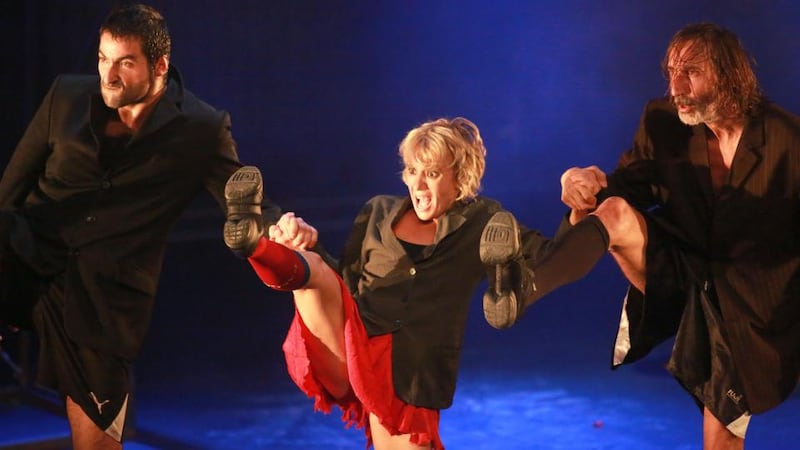It comes as something of a surprise, when walking along Hamilton Dock in Belfast’s Titanic Quarter, to encounter a ploughed field, its furrows stretching into the distance in perfect parallel lines. On closer inspection, it seems as though the furrows subtly change colour at random intervals.
Surely, from the vantage point of the Titanic Belfast building's top floor, all will be explained? Peering downwards, a couple of oddly shaped patches of purple, green and white emerge, which look a little like eyes. And they are. But it is only from the air that the full impact of Wish, Jorge Rodríguez-Gerada's amazing land-art portrait of a child's face, can be seen.
Images of this one-off creation by the festival’s Cuban-American artist-in- residence have been made available in online video footage and aerial photographs. Nevertheless, it seems a pity, given the input from local volunteers and community groups, that the reveal of this vast visual spectacle, comprising 30,000 pegs, 2,000 tonnes of sand and spread over 11 acres, is more accessible to passengers flying into Belfast City Airport than to the general public.

The unveiling of Wish signals the start of an event that used to be widely regarded as being second only to the Edinburgh Festival in scale and artistic significance. More recently, it seems to have lost its way. This year's truncated, 10-day programme was put in place in a six-month period by new director Richard Wakely, a native of Belfast and a graduate of Queen's University. A festival is only as good as the vision of its director and, in this case, continuity has not been the name of the game.
In the summer of 2011, after a successful five-year tenure, Graeme Farrow was appointed executive programmer for Derry UK City of Culture 2013. He was replaced by Mark Prescott, a former leading light in London lord mayor Boris Johnson's cultural team. But a few short months later, Prescott hightailed it back to England, leaving Shan McAnena, curator of Queen's University's Naughton Gallery, to step in as acting director, responsible for pulling together last year's landmark 50th event.
Now, the mantle has passed to the highly experienced Wakely, a former managing director of Dublin’s Abbey Theatre. And if his sincerely expressed enthusiasm and ambition for the job are anything to go by, he might just turn out to be the man who can reignite Belfast’s faltering love affair with its festival.
Spanish unrest
He has made a promising start. The keenly anticipated weekend of international dance has lived up to expectations, as expressed in a lively panel discussion, Europe Moves at The Mac, on Saturday afternoon.
What a thrill to see on stage later in the day the great dancer and choreographer Sol Picó, whose company, based in Barcelona, delivered an intense, visceral response to the economic chaos besetting Spain.
In Memories d'una Puça, two male dancers – Valentí Rocamora i Torà and Carlos Fernandez Fuentes – provide dramatic support to the diminutive Pico. The pounding soundtrack swirls and gyrates around the coda of the third movement of Swan Lake, with Tchaikovsky's glorious score cranked up to the max and the choreography similarly deconstructed and subverted. Ironic motifs of traditional Spain abound – bulls, flamenco, golf, football – but it is the detritus-strewn 21st-century landscape (rotting tyres, empty oil barrels, black bins bursting with refuse) that disturbs and offends. Pico's riveting presence seems to personify the country itself, ending up trapped in a giant plastic bottle, washed by the sea.
An uncertain relationship
Unsettling in an entirely different way is Victor, an intimate duet between a man and a boy, an uneven power struggle between muscular strength and youthful innocence. It is presented by the Belgian company Campo, whose artistic hallmark is a close focus on physical expression and the human body. Are these two beautiful people father and son? Are they the same man, older and younger? Is their relationship sweet and tender – or something else entirely?
Creators Peter Seynaeve and Jan Martens may be working together here for the first time, but what they have in common are their past portraits, of individuals and relationships. The result is an edgy fusion of Seynaeve's theatricality and Martens's distinctive dance vocabulary, at the centre of which is an ambiguous child/adult pairing, with the two roles beautifully danced by Viktor Caudron and Steven Michel.
The Ulster Museum and the Mac are the locations for the world premiere of Fearghus Ó Conchúir's Porous by Belfast company Maiden Voyage. Three female dancers – Vasiliki Stasinaki, Carmen Fuentes Guaza and Oona Doherty – move among the weekend visitors, tracing out the shapes of the buildings and the relationships that exist with the bodies that inhabit them. The uncertain reactions of the public to this apparently spontaneous performance and Alma Kelliher's architectural-inspired soundscape are all part of the experience.
The long, narrow space of the Naughton Gallery is the venue for Belgian artist Lawrence Malstaf's installation Conversations. Unintentionally perhaps, the dance theme continues, as a cluster of seven white chairs invite chats and encounters. Art meets new technology in this intriguing, unpredictable piece, where inanimate objects take on a life of their own, randomly vibrating and moving, encouraging and discouraging human interaction. It's witty and playful, representing the kind of slightly mad adventure that endows a festival with attitude.
The Belfast Festival at Queen’s continues until Sunday, belfastfestival.com












